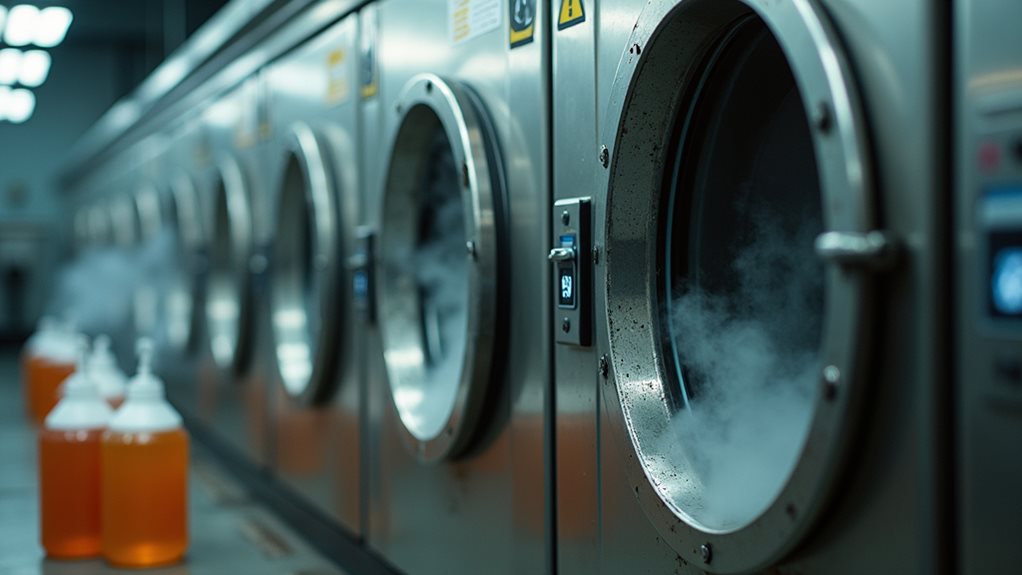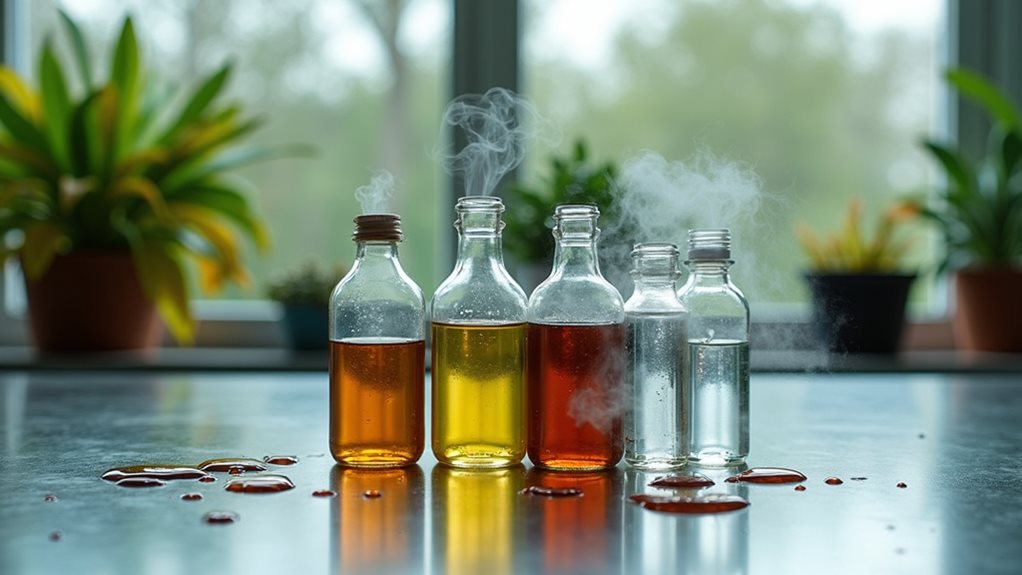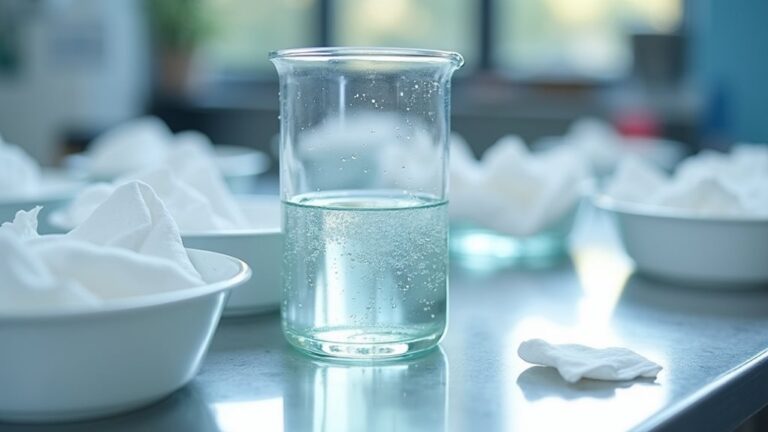Traditional dry cleaning isn’t as safe as you’d hope, since most facilities use perchloroethylene (PERC), a probable carcinogen that clings to your clothes like an unwelcome houseguest. You’re fundamentally bringing chemical vapors into your home that can cause headaches, dizziness, and long-term health risks, while workers face even greater dangers from daily exposure. Thankfully, eco-friendly alternatives and at-home care methods can help you avoid these risks while keeping your garments looking sharp.
The Chemicals Used in Traditional Dry Cleaning
When I first learned about the chemicals lurking in my freshly dry-cleaned blazers, I’ll admit I felt a bit like I’d been living under a rock for years 🪨.
I felt completely blindsided when I discovered the toxic chemicals hiding in my supposedly “clean” dry-cleaned clothes.
Turns out, most dry cleaning services rely on perchloroethylene, better known as PERC, which sounds innocent enough until you discover it’s classified as a probable human carcinogen.
These toxic chemicals don’t just vanish after cleaning—they cling to your clothes, especially wool and cotton fabrics, creating ongoing health risks every time you wear that crisp shirt.
The environmental impact extends beyond your wardrobe too, affecting workers and communities.
While the EPA’s planning a gradual phase-out, you don’t have to wait—safer alternatives exist that’ll keep your clothes clean without the cancer-causing chemicals.
Beyond cancer risks, PERC exposure can also lead to immediate health problems like skin irritation and respiratory issues, particularly for those who frequently wear freshly dry cleaned garments without proper airing.
Health Risks Associated With PERC Exposure

After digging deeper into PERC’s effects on human health, I discovered that this chemical doesn’t mess around when it comes to potentially serious consequences for your body.
This probable carcinogen has been linked to multiple myeloma and non-Hodgkin lymphoma, which honestly made me rethink my casual dry cleaning habits.
When you’re exposed to PERC, even short-term contact can trigger dizziness, headaches, and cognitive issues that’ll leave you feeling foggy.
The environmental impact extends beyond air quality, as chronic exposure threatens your reproductive system and immune function.
Dry cleaning workers face the highest health risks due to prolonged exposure in poorly ventilated spaces.
Studies have also shown increased risks of bladder cancer, esophageal cancer, and cervical cancer among workers with occupational exposure to PERC.
Thankfully, safer alternatives are emerging as regulations push the industry toward less toxic solutions.
Environmental Impact of Dry Cleaning Solvents

When you drop off your favorite shirt at the dry cleaner, you’re probably not thinking about where those chemical solvents end up, but the truth is they don’t just disappear into thin air—they seep into groundwater systems, escape through ventilation into our neighborhoods, and persist in ecosystems where they can harm marine life for years.
I used to assume that regulated businesses handled their waste responsibly, until I learned that PERC can contaminate drinking water supplies and linger in outdoor air for weeks, affecting entire communities around dry cleaning facilities.
The environmental ripple effects are honestly more extensive than most of us realize, touching everything from the soil beneath these shops to the air we breathe when we walk past them on busy streets 🌍.
Beyond chemical contamination, the industry generates substantial waste through single-use plastic garment bags and wire hangers that typically end up in landfills, adding another layer of environmental burden to an already problematic process.
Groundwater Contamination Risks
Although most of us drop off our favorite blazers and delicate dresses without a second thought, the environmental reality behind dry cleaning tells a much more sobering story that extends far beyond those plastic-wrapped garments.
PERC and other toxic chemicals don’t just vanish after cleaning your clothes—they seep into groundwater systems through improper disposal and facility leaks, creating contamination that can persist for decades. The Environmental Protection Agency has documented this widespread issue, finding these solvents in drinking water supplies across numerous communities.
Here’s what makes this particularly alarming:
- Your family’s drinking water could contain probable carcinogens without you knowing
- Contaminated groundwater affects crops and food production in surrounding areas
- Health risks accumulate over time, potentially causing long-term consequences
- Entire communities become vulnerable when their primary water sources are compromised
Beyond water contamination, occupational hazards pose significant risks to dry cleaning workers who face daily exposure to these toxic solvents.
Air Pollution Effects
Every breath you take near a dry cleaning facility could contain invisible PERC vapors that escaped through aging ventilation systems, lingering in the outdoor air for weeks like an unwelcome guest who just won’t leave.
This air pollution creates a ripple effect that’s honestly pretty unsettling when you think about it. These dry cleaning solvents don’t just disappear—they transform into toxic chemicals that can mess with our ozone layer, which we kinda need for, you know, survival 😅.
What really gets me is how PERC follows you home on your freshly cleaned clothes, quietly affecting your indoor air quality while you sleep.
The environmental impact extends beyond what we breathe, eventually finding its way into water systems and creating this interconnected web of contamination.
To minimize these risks, experts recommend allowing garments to air out completely before bringing them indoors, as this simple step can significantly reduce chemical exposure in your living space.
Ecosystem Damage Concerns
While we’ve been focusing on how dry cleaning chemicals affect human health, the truth is that these same toxic solvents are quietly wreaking havoc on entire ecosystems in ways that honestly kept me up at night once I started researching this topic.
PERC doesn’t just vanish after cleaning your clothes—it lingers in our environment for weeks, seeping into water systems and causing widespread contamination that threatens marine life and drinking water safety.
The ecosystem damage extends far beyond what you’d expect:
- Toxic chemicals accelerate ozone layer depletion, creating a ripple effect on environmental health
- Ground contamination destroys soil health, leaving ecosystems struggling to recover for years
- Air pollution from ventilation systems affects surrounding wildlife habitats
- Water contamination threatens entire food chains, from tiny organisms to larger marine species
When dry cleaning facilities improperly dispose of these chemical solvents, groundwater contamination becomes a serious long-term threat that can persist in the environment for decades.
Chemical Residue That Remains on Your Clothes

You might think dropping off your favorite wool suit or cotton dress at the dry cleaner means you’ll get it back perfectly clean, but here’s something that surprised me when I first learned about it: those chemical solvents don’t just disappear after cleaning.
The PERC and other harsh chemicals actually build up in your fabric fibers over time, creating a kind of invisible residue that travels home with you.
When you add heat to the equation—whether it’s from your body temperature, a warm closet, or even sunlight streaming through your window—those chemical levels can increase considerably.
What’s even more concerning is that when you store these freshly dry-cleaned garments in your bedroom closet or anywhere without proper ventilation, you’re fundamentally creating a slow-release system that gradually fills your home’s air with these potentially harmful vapors. 😬
Fortunately, many dry cleaners have switched to safer alternatives like liquid CO2 or hydrocarbon solvents to reduce these health and environmental risks.
PERC Builds in Fabrics
When I first learned that PERC doesn’t just disappear after dry cleaning, I felt like discovering my favorite restaurant had been serving food off dirty plates – it completely changed how I viewed those crisp, “clean” clothes hanging in my closet.
Here’s what makes PERC retention in fabrics particularly concerning:
- Cotton and polyester become chemical sponges, absorbing more PERC with each cleaning cycle.
- High-temperature cleaning processes actually force deeper chemical penetration into fabric fibers.
- Your “fresh” clothes continue releasing toxic vapors into your home’s indoor air for days.
- Wool retains the highest levels of chemical residue compared to delicate fabrics like silk.
The health risks multiply when you store these garments in poorly ventilated closets, fundamentally creating toxic clouds in your living space. Fortunately, many dry cleaning facilities are now adopting safer alternatives like wet cleaning, liquid CO2, and hydrocarbon solvents to reduce these chemical exposure risks.
Heat Increases Chemical Levels
Although my engineering background taught me that heat accelerates chemical reactions, I never connected this principle to my dry cleaning habits until I watched a technician explain how those steamy pressing machines fundamentally cook PERC deeper into fabric fibers.
The high temperatures used during dry cleaning don’t just remove wrinkles—they’re actually forcing chemical levels deeper into your fabrics, creating a perfect storm for increased health risks.
When you bring those freshly pressed clothes home, they’ve practically become slow-release chemical dispensers, contributing to indoor air pollution as PERC gradually evaporates into your living space.
It’s like having tiny time bombs in your closet, quietly releasing toxins that you’ll inhale daily.
While PERC itself is generally non-flammable, the combination of heat and chemical handling requires strict safety protocols to minimize various hazards in professional dry cleaning facilities.
Understanding this heat-chemical relationship completely changed how I approach professional garment care.
Home Storage Risks
The real nightmare begins once those heat-treated garments make their way into your home, where they’ll continue releasing PERC for days or even weeks after you’ve hung them in your closet.
I learned this the hard way when my favorite wool blazer turned my bedroom into a chemical soup 😅. The storage location you choose directly impacts your indoor air quality, as these chemical residues don’t just disappear overnight.
Here’s what makes home storage particularly concerning:
- Cotton and polyester fabrics retain considerably higher PERC levels than silk
- Confined closet spaces trap vaporizing chemicals, creating concentrated exposure zones
- Daily contact with contaminated garments increases your cumulative health risks
- Poor ventilation allows PERC accumulation, affecting your family’s breathing space
Studies have suggested potential links between PERC exposure and bladder cancer, along with esophageal and kidney cancers, making proper ventilation even more critical for your health.
Always store dry cleaning in well-ventilated areas and air them out thoroughly before wearing.
Safer Alternatives to Traditional Dry Cleaning

While traditional dry cleaning might seem like your only option for those delicate fabrics, you’ll be relieved to discover that several safer alternatives can keep your clothes looking pristine without exposing you to harsh chemicals like PERC.
You can explore eco-friendly options like liquid silicone (D5) or liquid CO2 cleaning, which are non-toxic and biodegradable – honestly, it’s amazing how these alternatives to PERC work just as effectively!
Many “dry clean only” labels are actually more suggestion than law, and you can often hand wash these items using gentle detergents and cold water.
At-home dry-cleaning kits offer another brilliant solution, letting you refresh garments safely. Plus, steamers eliminate wrinkles without any chemicals whatsoever! 😊
When Professional Cleaning Is Actually Necessary

However tempting it might be to wash everything at home after learning about those wonderful alternatives, certain situations genuinely require professional attention, and recognizing these moments can save you from heartbreak when your favorite garment gets ruined.
When dry cleaners use alternative solvents and specialized techniques, they’re protecting investments you can’t replace at Target. Professional cleaning becomes crucial when you’re dealing with items that have “dry clean only” labels, since these delicate fabrics weren’t designed for your washing machine’s aggressive cycles.
Here’s when you absolutely need professional help:
- Beaded evening gowns – Those glued embellishments will scatter like confetti 🎉
- Silk blouses with intricate pleating – Home washing turns elegant into crumpled mess
- Wool blazers – Shrinkage transforms professional wear into dollhouse clothing
- Vintage pieces – Irreplaceable garments deserve expert care
Regular maintenance through professional cleaning without compromise guarantees your special pieces survive decades, not merely seasons.




